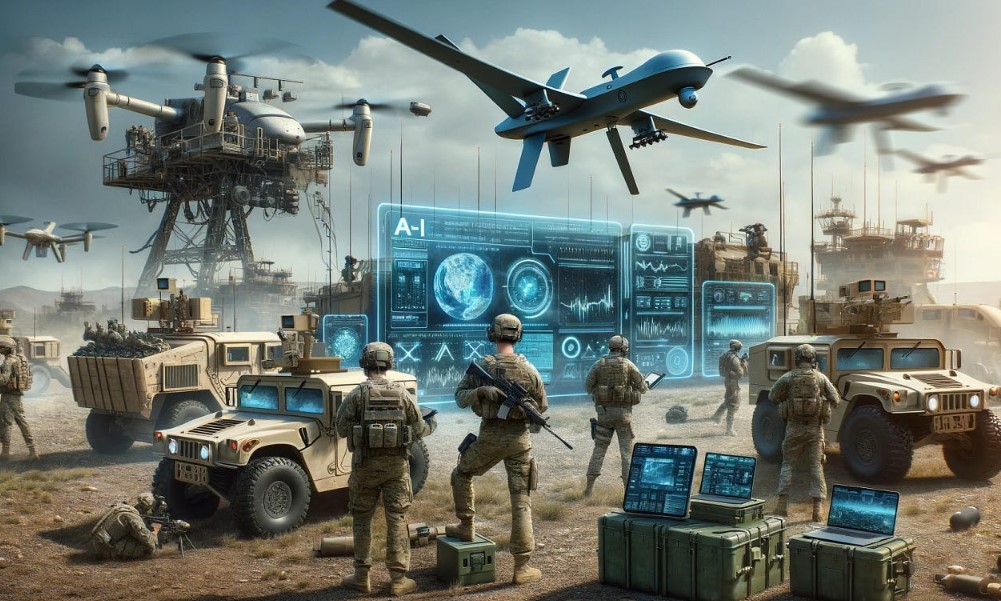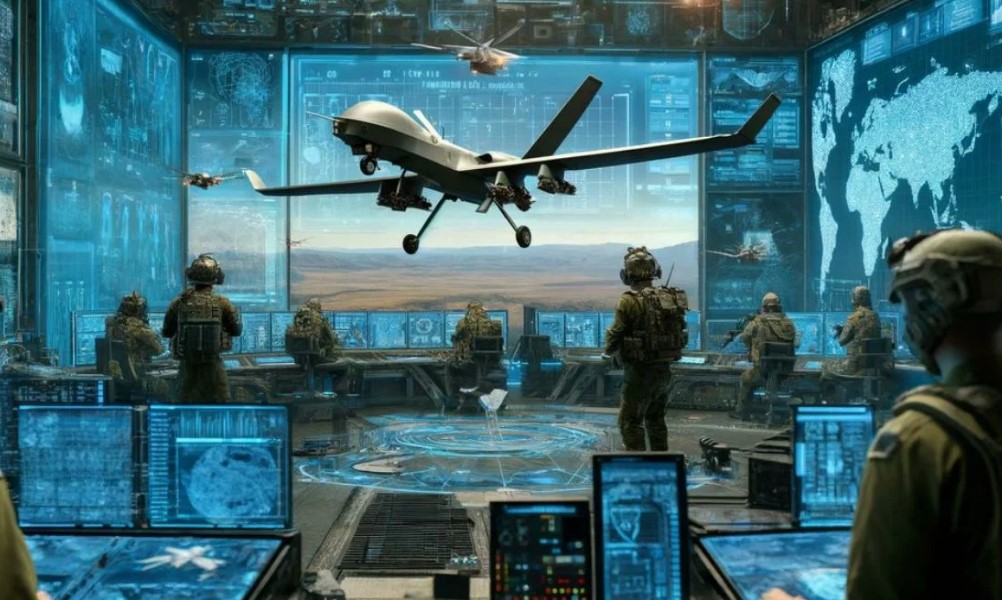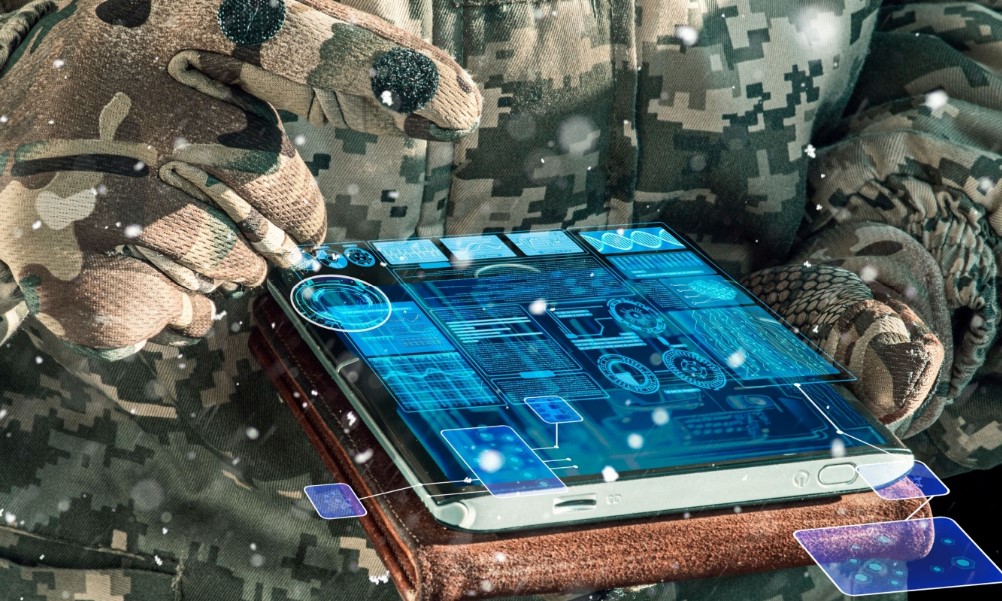In today’s rapidly changing technological landscape, Artificial Intelligence (AI) is playing a transformative role across numerous industries. One area where its impact is increasingly visible is in warfare. The integration of AI into military operations has revolutionized how battles are fought, providing military forces with advanced tools that enhance decision-making, reduce human casualties, and improve the efficiency of defense systems.
The Evolution of AI in Warfare

1. Understanding AI’s Role in Modern Military Operations
Artificial Intelligence has moved from being a theoretical concept to a strategic asset in warfare. The ability of AI to analyze vast amounts of data, automate systems, and predict outcomes has drastically changed the nature of military operations.
Instead of relying solely on human intelligence and brute force, AI enables militaries to deploy smarter, more efficient strategies that prioritize precision and speed.
Key areas where AI is currently making an impact include:
- Autonomous Weapons Systems: AI powers systems that can operate without direct human intervention. Drones, for instance, are equipped with AI algorithms that allow them to navigate, identify targets, and carry out missions autonomously.
- Predictive Analytics: Military forces use AI to analyze vast datasets from satellites, surveillance, and other intelligence sources. This data allows for predictions regarding enemy movements, supply chain efficiency, and battlefield outcomes.
- Cybersecurity: AI enhances cybersecurity measures by identifying and neutralizing cyber threats in real time. This is essential as modern warfare increasingly involves attacks on critical infrastructure and communication networks.
The integration of AI into these key areas allows military forces to respond more quickly, make better-informed decisions, and protect their assets more effectively.
Key Consideration of AI in Warfare

Artificial Intelligence (AI) is rapidly reshaping modern warfare, offering significant advantages in terms of automation, decision-making, and operational efficiency. However, deploying AI in military applications comes with several key considerations. These include ethical challenges, the risk of autonomy, reliability, and the implications for global security.
1. Ethical Implications
One of the most pressing considerations when using AI in warfare is the ethical aspect. Autonomous systems can make life-or-death decisions without human intervention, raising concerns about accountability. The risk of AI systems malfunctioning or making incorrect decisions can lead to unintended consequences, including civilian casualties. As a result, ethical frameworks must be developed to ensure that AI in warfare operates within acceptable moral boundaries.
- Feature: Autonomous decision-making
- Challenge: Accountability in the event of errors or unintended harm.
2. Reliability and Accuracy
AI systems must be highly reliable, especially when deployed in life-critical applications like defense. Machine learning algorithms are dependent on the quality and volume of data they receive, which can introduce biases or lead to incorrect predictions. Ensuring that these systems operate consistently under diverse conditions is vital for their successful deployment in warfare.
- Feature: Data-driven algorithms
- Challenge: Ensuring accuracy in unpredictable environments.
3. Cybersecurity Risks
As AI becomes more integrated into military systems, the potential for cyberattacks increases. AI-powered systems can become targets of hackers looking to manipulate algorithms or shut down autonomous systems. Robust cybersecurity measures are critical to prevent these systems from being compromised and used against their intended users.
- Feature: Autonomous cybersecurity defenses
- Challenge: Vulnerability to hacking and system breaches.
4. Human Oversight
Even as AI takes over many tasks in warfare, maintaining a level of human oversight is crucial. Humans need to remain in control of critical decision-making processes to avoid errors caused by AI misinterpretation of data or unforeseen circumstances.
- Feature: Human-in-the-loop systems
- Challenge: Balancing autonomy with necessary human control.
5. Global Security Implications
AI in warfare may lead to an arms race, as nations strive to develop more sophisticated and autonomous military systems. This has implications for global security, as countries may become more inclined to deploy AI in conflicts, increasing the risks of escalation.
- Feature: AI-powered autonomous weapons
- Challenge: Potential for misuse and global arms escalation.
Top 5 AI Solutions in Warfare: Products Leading the Charge

Several companies and defense contractors are at the forefront of AI technology in warfare. These solutions range from autonomous drones to advanced cybersecurity systems, each serving unique functions that are crucial for modern military operations.
Here’s a closer look at the top AI-powered products reshaping warfare in 2024.
1. Lockheed Martin Autonomous Drone System
Lockheed Martin, a global leader in defense technology, has developed an AI-powered drone system that brings autonomy to the battlefield. This drone is capable of conducting reconnaissance missions, surveillance, and even engaging in combat without human intervention. The integration of AI allows the drone to adapt in real-time, making decisions based on the data it gathers.
- Price: $1.5 million per unit
- Key Features:
- Autonomous navigation
- Real-time target identification and engagement
- Enhanced flight stability using AI-driven algorithms
- Benefits:
- Reduces human casualties by conducting high-risk missions.
- Provides real-time intelligence without the delay caused by human decision-making.
- Operates in harsh environments where human presence is difficult or dangerous.
- Use Case: These drones have been used extensively in hostile territories for surveillance and targeted strikes. By using advanced vision-based navigation and AI-driven decision-making, they can identify and eliminate targets with pinpoint accuracy.
- Where to Buy: Lockheed Martin Autonomous Drone System
2. Palantir Defense Platform
Palantir, a company known for its data analytics prowess, has developed a defense platform that uses AI to help military personnel analyze large amounts of data and make better decisions. By aggregating data from multiple sources, Palantir’s AI-powered platform allows military commanders to predict enemy movements, anticipate supply shortages, and optimize battlefield strategies.
- Price: Custom pricing based on deployment size and customization
- Key Features:
- Predictive analytics for battlefield decision-making
- Real-time data aggregation from satellites, drones, and ground units
- Machine learning algorithms that continuously improve as more data is collected
- Benefits:
- Allows military commanders to make faster, more accurate decisions based on real-time data.
- Reduces the risk of unexpected outcomes by providing predictive insights.
- Helps optimize logistics and resource management in complex battlefield environments.
- Use Case: Palantir’s platform has been used in large-scale military operations to predict enemy behavior and logistics challenges. For example, in joint operations with allied forces, it helps anticipate where resources are needed most and when.
- Where to Buy: Palantir Defense Platform
3. DARPA Gremlins Program
The Defense Advanced Research Projects Agency (DARPA) has pioneered the Gremlins Program, which deploys AI-powered drones in large swarms to carry out missions that traditional single-unit drones cannot handle. The Gremlins are small, cheap, and designed for rapid deployment.
- Price: $2 million per swarm deployment
- Key Features:
- Autonomous drone swarms with AI-driven coordination
- Capable of jamming enemy radar and communications
- Multiple mission adaptability based on AI algorithms
- Benefits:
- Disrupts enemy defenses by overwhelming radar systems with multiple targets.
- Can be quickly deployed and retrieved, reducing the need for large ground operations.
- Offers a cost-effective solution for large-scale drone deployment.
- Use Case: The Gremlins have been used in large-scale operations where traditional drones would be ineffective. Their AI capabilities allow them to jam radar systems and perform coordinated attacks on enemy communication networks.
- Where to Buy: DARPA Gremlins Program
4. Raytheon AI Cyber Defense System
Raytheon, a major player in the defense industry, has developed an AI-driven cybersecurity system that detects and mitigates cyber threats in real-time. As modern warfare increasingly involves cyberattacks, the need for advanced, AI-powered cybersecurity systems has never been greater.
- Price: Custom pricing depending on the deployment scale
- Key Features:
- Real-time threat detection
- AI-driven automated response to neutralize threats
- Continuous learning system that adapts to new types of cyber threats
- Benefits:
- Protects critical military infrastructure, including communication networks and weapons systems.
- Provides 24/7 monitoring and defense against cyberattacks.
- Reduces the need for human intervention, which can be slower and prone to error.
- Use Case: Raytheon’s AI Cyber Defense system is used to protect sensitive military communications from hacking attempts. It has been deployed in high-stakes environments where cyber threats are constant and require immediate response.
- Where to Buy: Raytheon AI Cyber Defense System
5. Anduril Lattice Platform
The Anduril Lattice Platform combines sensors, drones, and AI to provide complete situational awareness on the battlefield. This platform uses AI to integrate various defense systems, offering commanders a real-time view of their operational environment.
- Price: Custom pricing based on system configuration
- Key Features:
- Autonomous integration of sensors and drones
- Real-time situational awareness powered by AI
- Seamless integration with existing defense systems
- Benefits:
- Provides a comprehensive view of the battlefield, allowing for quicker, more informed decisions.
- Reduces the likelihood of operational errors by automating data analysis and integration.
- Enhances the effectiveness of defense systems by providing real-time updates on the position of friendly and enemy forces.
- Use Case: Anduril’s Lattice Platform is used in border security and battlefield operations where real-time situational awareness is critical. The AI-powered integration of drones and sensors provides military leaders with an accurate picture of their operational environment, allowing for more precise action.
- Where to Buy: Anduril Lattice Platform
Comprehensive Product Comparison Table
| Product | Price | Use Case | Advantages | Disadvantages | Key Features |
|---|---|---|---|---|---|
| Lockheed Martin Autonomous Drone | $1.5 million/unit | Surveillance & strikes | Fully autonomous, reduces human casualties | High cost | Real-time target recognition, AI-driven navigation |
| Palantir Defense Platform | Custom pricing | Battlefield prediction | Predictive insights, real-time data visualization | Expensive to set up | AI-based predictive algorithms, data aggregation |
| DARPA Gremlins Program | $2 million/swarm | Large-scale drone strikes | Autonomous swarm coordination, jamming technology | Limited use in specific operations | AI-based coordination, low cost per drone |
| Raytheon AI Cyber Defense System | Custom pricing | Cybersecurity | 24/7 threat detection, automated response | Limited to digital defense | AI-driven threat mitigation, continuous learning |
| Anduril Lattice Platform | Custom pricing | Situational awareness | Full battlefield visibility, real-time updates | Complex integration required | Autonomous sensor integration, real-time AI updates |
Benefits of Using AI-Powered Defense Systems

The benefits of utilizing AI in warfare extend beyond just efficiency. Here are the key benefits associated with these systems:
1. Enhanced Decision-Making Speed and Accuracy
AI can process massive amounts of data at speeds that human operators cannot match. This allows military commanders to receive real-time insights and make faster, more accurate decisions.
2. Improved Operational Efficiency
AI-powered autonomous systems, such as drones and surveillance platforms, can perform tasks without the need for human intervention, reducing the workload on soldiers and allowing for more streamlined operations.
3. Cost-Effectiveness
While the upfront cost of AI-powered systems can be high, they reduce long-term operational costs by automating processes that would otherwise require significant human and material resources.
4. Reduced Human Casualties
By delegating high-risk tasks to AI-powered autonomous systems, militaries can reduce the number of soldiers required to perform dangerous missions, decreasing the likelihood of casualties.
5. Better Intelligence Gathering
AI systems, such as those offered by Palantir, excel at aggregating and analyzing data from various sources. This leads to more comprehensive intelligence and a clearer understanding of the battlefield.
How to Buy AI Defense Systems
Acquiring AI-powered defense systems involves several key steps:
- Assess Your Needs: Identify whether your primary requirement is for surveillance, cybersecurity, or battlefield automation.
- Contact Manufacturers: Reach out to companies such as Lockheed Martin, Palantir, or Anduril for product consultations.
- Request a Demo: Most defense companies offer demos or simulations to showcase how their products can meet your operational needs.
- Secure Funding: Many of these systems require significant investment, so ensure you have the necessary budget.
- Place Orders: Once you’ve finalized the product and configuration, place your order directly through the manufacturer’s website or authorized dealers.
FAQs
1. What are the main applications of AI in warfare?
AI is used in various applications in warfare, including autonomous drones, predictive analytics, and cybersecurity, to enhance decision-making and reduce human casualties.
2. How does AI improve the accuracy of military operations?
AI algorithms analyze vast amounts of data in real-time, allowing for more precise targeting, navigation, and decision-making, thereby improving the accuracy of military operations.
3. Can AI systems in warfare operate autonomously?
Yes, many AI systems, such as drones and cybersecurity platforms, can operate autonomously without direct human intervention, allowing them to perform tasks like reconnaissance and threat mitigation.
4. How much does it cost to deploy an AI-powered defense system?
The cost varies widely depending on the system. For example, Lockheed Martin’s autonomous drones cost approximately $1.5 million per unit, while Palantir’s defense platform offers custom pricing.
5. Where can I purchase AI-powered military systems?
AI-powered military systems can be purchased directly from manufacturers like Lockheed Martin, Palantir, Raytheon, and Anduril. It’s best to contact them for product consultations and pricing.